Search engine optimization often feels overwhelming, especially when you’re just starting out. There are dozens of terms to remember, constant algorithm updates, and countless strategies to choose from.
For business owners and marketing beginners, this complexity can become a barrier to action.
That’s where visual frameworks can help. Much like the periodic table in chemistry organizes elements by their properties, an SEO periodic table breaks down optimization practices into clear, structured categories.
It gives a bird’s-eye view of how everything connects and what deserves attention.
This beginner-friendly guide will explain how the SEO periodic table works and how you can create or adapt one for your own learning or team training.
Whether you’re managing your website or guiding a content team, this structured approach can simplify SEO into manageable, logical sections.
Table of Contents
What Is an SEO Periodic Table?
An SEO periodic table is a visual framework that organizes key elements of search engine optimization into structured categories. The original SEO periodic table was introduced by Search Engine Land in 2011.
Inspired by the format of the chemical periodic table, this approach helps users understand the various components of SEO (technical, on-page, off-page, content, and user experience) at a glance.
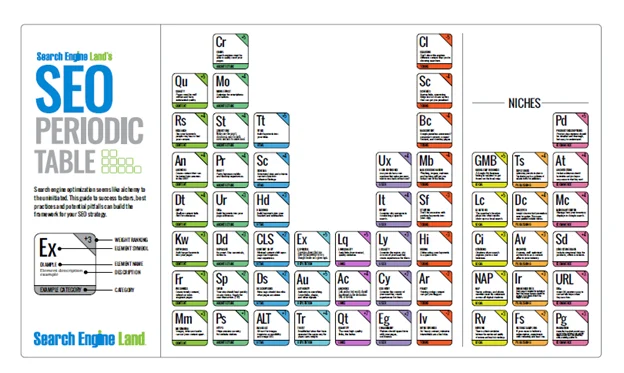
SEO Periodic Table of Search Engine Land
Instead of treating SEO as a chaotic list of tasks, the table breaks it down into “families” of practices. Each “element” within the table represents a specific SEO factor, such as title tags, site speed, backlinks, or content quality.
These elements are grouped and color-coded based on their nature and function.
Some tables also use ranking or weighting to indicate the relative importance of each factor. Others may highlight which elements are considered foundational versus optional or advanced.
The goal is not to replace strategy or data but to provide a simplified, bird’s-eye view. For beginners, it’s an excellent way to see the bigger picture and understand how the different parts of SEO contribute to a site’s visibility and performance.
Why Use a Periodic Table Approach for SEO Learning?
For many business owners, SEO can seem like a mix of technical jargon, endless tools, and shifting rules.
This confusion makes it hard to know where to begin or what matters most. An SEO periodic table can simplify this challenge by offering a structured, visual way to understand and prioritize SEO activities.
Here’s why the periodic table format is so effective:
- Improved Clarity and Organization: Grouping SEO tasks into categories helps you see how everything fits together. It turns chaos into structure, reducing overwhelm for beginners.
- Better Retention and Understanding: Visual learners benefit from seeing SEO concepts mapped out. It’s easier to remember “families” of related tactics when they’re organized by color, label, or grouping.
- Excellent Training and Onboarding Tool: Whether you’re hiring SEO staff or training your marketing team, the table offers a simple visual reference that supports structured learning.
- Easy Prioritization and Strategy Planning: You can focus your time and resources on high-impact areas by seeing which elements are most essential (like mobile optimization or content quality).
- Adaptable and Scalable: The periodic table can evolve with your business. You can start with a simple version and build it out as your team becomes more experienced.
- Helps Avoid Common SEO Blind Spots: Often, business owners focus too much on keywords while ignoring technical issues. A well-structured table keeps everything in view.
Core Categories of the SEO Periodic Table
The periodic table approach divides the discipline into several prominent families or categories to make SEO easier to understand and apply.
Each family includes a group of elements that work together to impact search visibility. This structured breakdown ensures that you’re not just focusing on one area (like content) while ignoring equally important aspects like technical health or trust signals.
Below are the foundational categories typically featured in an SEO periodic table. Each section provides an overview and a breakdown of essential elements in that category.
Technical SEO Elements
Technical SEO lays the groundwork for your entire website’s search performance. Even the best content may not be properly indexed or ranked without strong technical health. This category focuses on site infrastructure and crawlability.
Key technical elements include:
- Crawlability: Ensures search engines can access and understand your pages. Elements like robots.txt and clean URL structures play a big role here.
- Indexability: Involves making sure pages can be stored in Google’s index. Correct use of meta tags like “noindex” is essential.
- Site Speed: Faster websites lead to better user experience and ranking potential. Load times affect bounce rates and crawl budget.
- Mobile-Friendliness: Mobile-first indexing means that Google primarily evaluates your site based on its mobile version. Responsive design is now a baseline requirement.
- HTTPS (Secure browsing): A secure website builds trust and is considered a ranking factor. SSL certificates are a must for any modern business site.
- XML Sitemaps: Help search engines discover and prioritize your important pages. It’s a map that guides crawlers efficiently through your site.
- Canonical Tags: Prevent duplicate content issues by signaling which version of a page should be treated as the original.
On-Page SEO Elements
On-page SEO is about optimizing the individual pages of your website to make them more understandable for both users and search engines. It deals with the structure and content formatting of each page.
Key on-page elements include:
- Title Tags: These are clickable headlines that appear on search engine results pages. A well-optimized title helps with both ranking and click-through rates.
- Meta Descriptions: Though not a direct ranking factor, compelling meta descriptions improve user engagement and inform search intent.
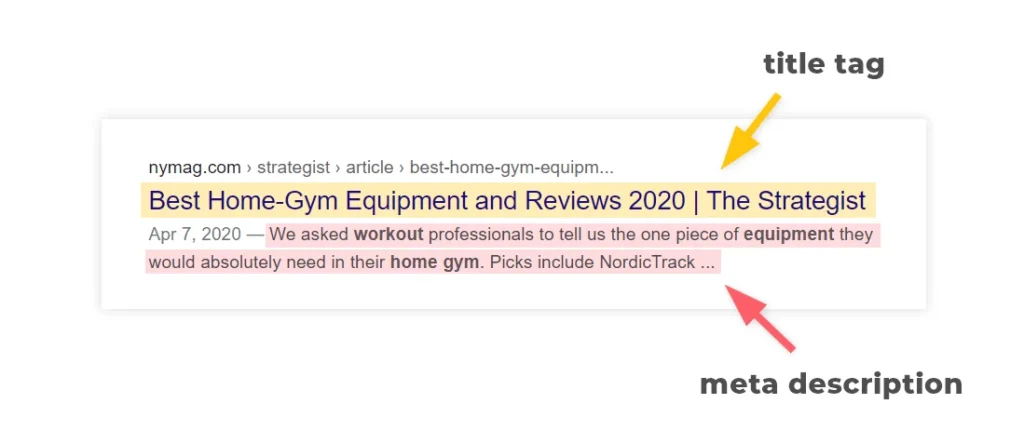
- Header Tags (H1–H6): These organize content into logical sections. They improve readability and help search engines understand the page structure.
- URL Structure: Clean, keyword-friendly URLs aid both user comprehension and crawler efficiency.
- Internal Linking: Helps distribute page authority and guide users deeper into your site. It also strengthens topical relevance between pages.
- Alt Text for Images: Describes image content for accessibility and SEO. It contributes to image search rankings and page relevance.
- Structured Data/Schema Markup: Adds extra context to your pages, enabling enhanced features like rich snippets in search results.
Content Elements
Content is the core driver of organic traffic. However, in the SEO periodic table, content is about creating valuable, relevant, and trustworthy material that satisfies searcher intent.
Strong content builds authority, encourages shares, and supports conversion goals over the long term.
Key content elements include:
- E-E-A-T (Experience, Expertise, Authoritativeness, Trustworthiness): Google looks for credible content written by knowledgeable sources that demonstrate a good reputation. This is especially important in finance, health, and legal niches.
- Keyword Usage and Intent: Matching content to the correct search intent (informational, transactional, etc.) will improve both rankings and user satisfaction. Natural placement of keywords in headings and body text is still essential.
- Content Freshness: Regularly updating content can help maintain its relevance and rankings, particularly in fast-changing industries.
How Often Should Content Be Updated – Neil Patel
- Topical Relevance: The more deeply your content explores a subject, the more likely it is to rank well. It means covering subtopics, FAQs, and related concepts.
- Content Depth: Thin content rarely performs well. In-depth articles that solve problems or answer complex questions attract more links and engagement.
- Media Richness: Including images, videos, infographics, and other media types enhances content quality and improves dwell time.
Off-Page SEO Elements
Off-page SEO focuses on how external factors contribute to a site’s authority and trustworthiness. These signals originate outside the website but significantly affect how search engines evaluate content.
Strong off-page SEO boosts visibility and cements your brand’s position as a trusted source in its industry.
Key off-page elements include:
- Backlinks: High-quality links from authoritative sites act as endorsements. They tell search engines that your content is valuable and credible.
- Brand Mentions: Even unlinked references to your business or website contribute to brand awareness and trust signals. They show that your brand is part of relevant conversations.
- Social Proof and Sharing: Engagements on social platforms can indirectly influence SEO. While shares don’t guarantee rankings, they increase content visibility and potential backlink opportunities.
- Guest Posting and PR: Publishing on reputable third-party sites increases exposure and builds strong backlinks, enhancing domain authority over time.
User Experience Signals
User experience (UX) has become a critical ranking factor. Google uses behavioral data to understand how users interact with a website and reward pages that deliver smooth, engaging experiences.
UX optimization aligns business goals with user satisfaction, leading to better performance across both rankings and conversions.
Key UX elements include:
- Bounce Rate: A high bounce rate can indicate that users aren’t finding what they need. Optimizing content to match intent helps keep visitors engaged.
- Dwell Time: The longer someone stays on a page, the more relevant the content will likely be. High dwell time signals satisfaction and content depth.
- Core Web Vitals: These measure how fast a page loads, how quickly it becomes interactive, and its visual stability. They are now part of Google’s ranking criteria.
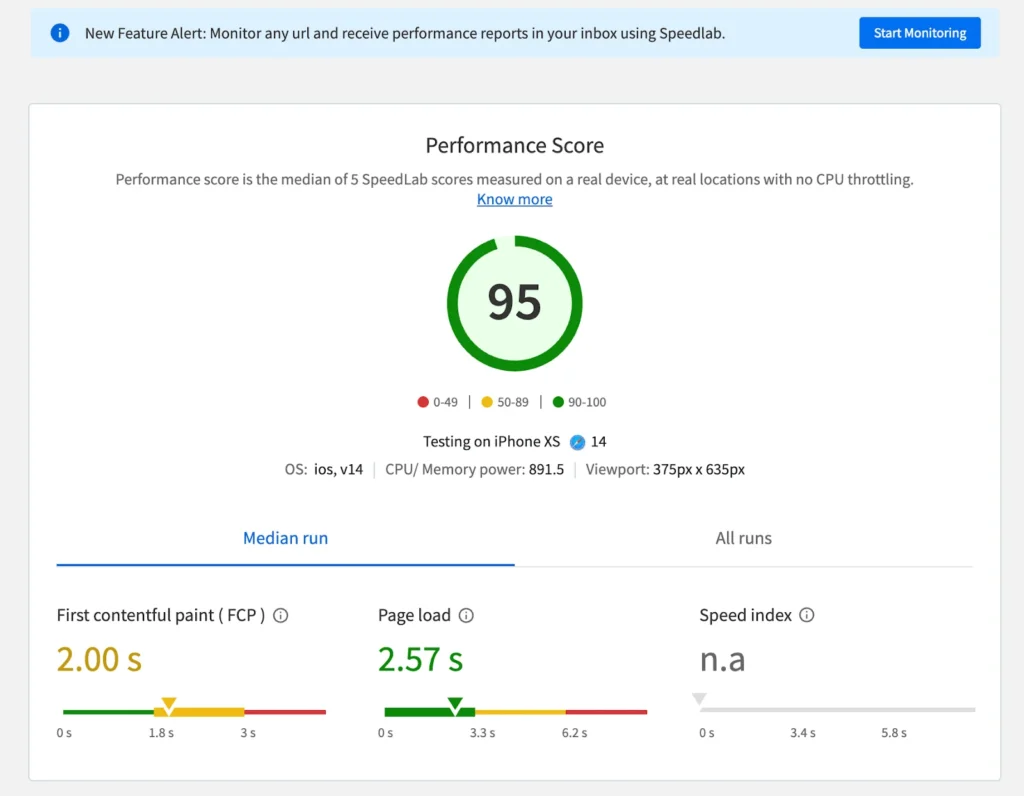
Source: BrowserStack
- Navigation Clarity: Clear menus, breadcrumbs, and a clean layout help users explore your site easily, improving both engagement and crawlability.
Penalty/Spam Triggers
Just as there are best practices, there are also critical mistakes that can hurt SEO performance. These elements typically fall under black-hat or outdated tactics that violate search engine guidelines.
Avoiding these red-flag practices ensures a sustainable SEO strategy and protects the site from ranking drops or manual actions.
Key spam triggers include:
- Keyword Stuffing: Overloading content with keywords makes it unreadable and signals manipulation. Google’s algorithms can detect and penalize such pages.

- Cloaking: Showing different content to users and search engines is considered deceptive. It undermines trust and can lead to severe penalties.
- Duplicate Content: Copying content from other pages or domains dilutes originality and affects indexability. Search engines prefer unique, original material.
- Thin Content: Pages with minimal value (like placeholder text or shallow blog posts) fail to satisfy user intent. These offer little SEO benefit and may harm site authority.
- Hidden Text or Links: Intentionally hiding SEO elements from users is a red flag. Transparency is key to building long-term trust and compliance.
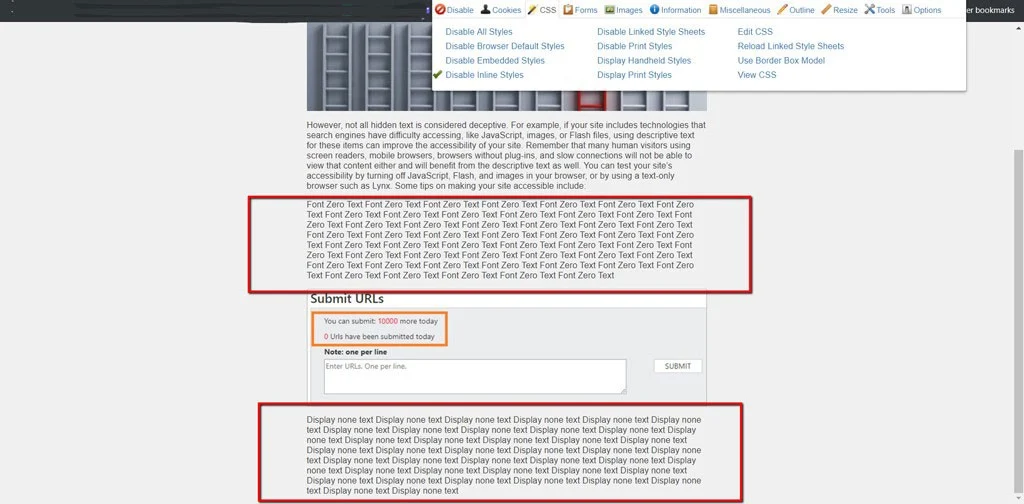
Source: Diib Learning Center
How to Design Your Own SEO Periodic Table
Creating a personalized SEO periodic table can allow for a structured, visual approach to mastering SEO. Instead of trying to memorize scattered tactics or tools, the table helps consolidate what matters most to your business, team, and growth strategy.
It can serve as both an educational framework and an operational checklist, adapting as SEO evolves.
Step 1: Define Your SEO Goals and Audience
Start by identifying the primary goals for your SEO efforts. Is it to drive local traffic, increase eCommerce sales, or rank informational blog content?
Knowing this shapes the importance you assign to certain elements. For instance, local SEO elements like NAP citations or Google Business Profile optimization might be more critical for service-based businesses.
Also, consider who will use this table (your internal team, freelancers, or agency partners) and tailor the depth accordingly.
Step 2: Choose Core Categories That Fit Your Strategy
Use the broad families outlined earlier (like technical SEO, content, off-page, and UX signals) as your table’s foundation.
You may want to merge or split categories based on relevance. For example, if video is central to your content, you could create a separate category like “Visual SEO.”
Keep categories distinct to avoid clutter and make the table easier to use during audits or strategy sessions.
Step 3: Assign Key Elements Within Each Category
Select specific elements under each core category. Limit the number per group to avoid overcomplication. Prioritize elements with the highest impact on your current SEO standing and competitive landscape.
For clarity, use short labels and consistent formatting (just like a real periodic table). Color-coding each category will help with quick recognition.
Step 4: Make It Visual and Interactive
Design your table using spreadsheet software, online design tools, or visual collaboration platforms like Miro or Canva.
If used frequently by a team, consider making the table clickable, where each element links to SOPs, tutorials, or checklists.
Over time, keep it updated as algorithms shift and priorities evolve.
Step 5: Review and Iterate
SEO is not static. Revisit your table quarterly or biannually to reflect performance metrics, algorithm updates, or strategic pivots.
Treat the table as a living document that evolves with your growth and industry trends. A well-maintained version can become a powerful internal resource.
Real-World Use Cases of SEO Periodic Tables
SEO periodic tables are actively used across teams to streamline digital strategy. For many businesses, they serve as onboarding frameworks for new marketers or freelancers. Instead of diving into SEO randomly, newcomers can learn from a categorized, simplified layout.
Marketing managers also use them to guide regular SEO audits. Each element becomes a checkpoint for technical errors, content gaps, or off-page opportunities. By reviewing each part, it’s easier to ensure no critical area is overlooked.
Agencies and consultants frequently use SEO periodic tables to align discussions with clients. Whether explaining why Core Web Vitals matter or how structured data works, the visual breakdown helps clarify priorities without overwhelming jargon.
Even solo entrepreneurs can use them to organize their own SEO calendars. When tasks are tied to specific elements in the table, scheduling becomes more intentional and trackable over time.
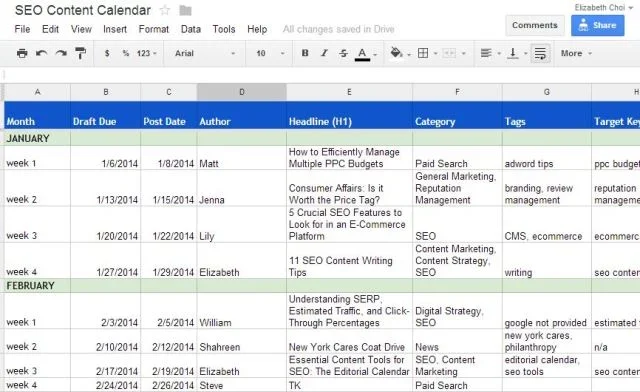
Exemplary SEO Calendar
Examples of Existing SEO Periodic Tables
There are already some well-known SEO periodic tables available online. These models offer practical blueprints for structuring SEO knowledge while also demonstrating how you might customize your own version.
Search Engine Land’s SEO Periodic Table
Arguably the most famous version, Search Engine Land’s table categorizes elements by on-page, off-page, content, architecture, and violations. It includes positive and negative ranking factors, each weighted in terms of importance.
The visual format is clean and color-coded, making it easy to digest. It serves as both a high-level guide and an actionable checklist for businesses.
SEMrush SEO Periodic Table
SEMrush released its own interpretation focused more on ranking signals and tools. Their model includes categories for keyword research, competitive analysis, and performance monitoring.
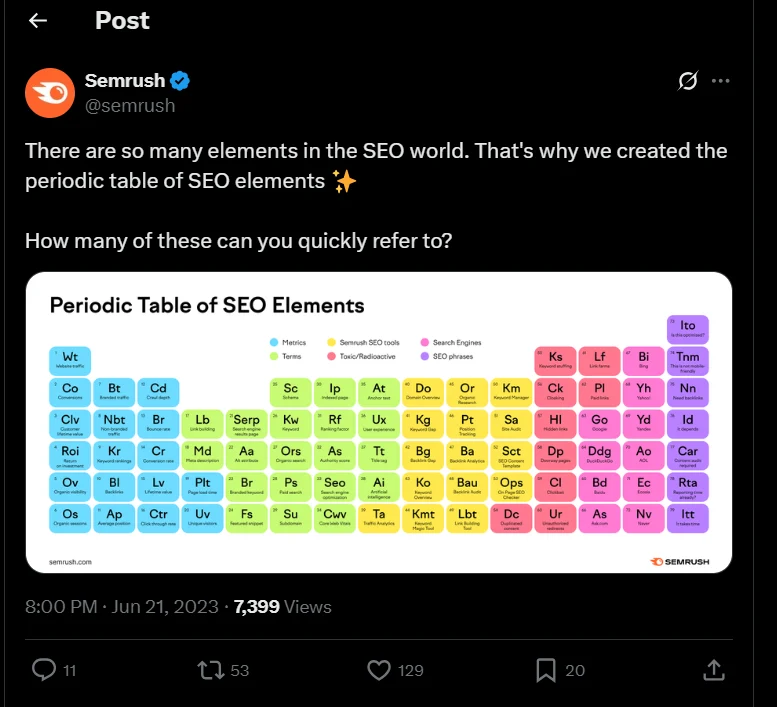
It integrates SEMrush’s suite, making it useful for those using the platform. However, it still works as a general strategic map even outside the tool ecosystem.
Aleyda Solis’s Learning SEO Periodic Table
Aleyda Solis, a well-respected SEO consultant, offers a unique visual periodic table as part of her Learning SEO roadmap. This table is structured around key SEO disciplines such as crawling, indexing, on-page optimization, technical audits, and more.
Each section links to curated learning resources (articles, tools, videos), making it especially useful for those seeking a guided path. It’s visually organized and interactive, turning the periodic table into a living curriculum.
This model is excellent for self-learners and teams that need structured training. While simple in design, it delivers a clear overview of how each SEO category connects to real-world action.
Common Mistakes to Avoid When Building or Using an SEO Periodic Table
A periodic table is only useful when applied correctly. These common missteps often weaken its effectiveness:
- Overloading with Jargon: Using too many technical terms can overwhelm beginners. Prioritize clarity and simplicity over complexity.
- Skipping Prioritization: Not all elements have equal weight. Failing to highlight high-impact factors can dilute the learning process.
- Focusing Only on On-Page SEO: Neglecting technical and off-page elements can create blind spots in a full SEO strategy.
- Using Outdated Information: SEO changes often. Relying on an outdated periodic table risks building strategies on deprecated practices.
- Treating It as a One-Time Tool: A periodic table should evolve with your skills and industry trends. Treat it as a living document, not a static resource.
Final Tips for Beginners
As you build or adopt your own SEO periodic table, keep these beginner-friendly tips in mind:
- Start with What You Understand. Focus on categories you’re familiar with and expand gradually.
- Use Visuals to Aid Memory. Color coding and grouping can help you internalize SEO concepts faster.
- Cross-Reference with Real Data. Pair periodic elements with performance reports from tools like Search Console or GA4.
- Review It Monthly. Check if new trends or priorities require updates.
- Use It as a Checklist, Not a Rulebook. Flexibility matters. Adapt the table based on your business goals and audience needs.
How to Integrate the SEO Periodic Table Into Your Workflow
Creating or adopting an SEO periodic table is one thing; integrating it into daily tasks is where the real value lies. The goal is not just to reference it occasionally, but to make it a core part of your SEO decision-making.
Start by aligning the table with your existing workflow. If you’re doing a content audit, map the elements under “content” and “on-page SEO” to your checklist.
Use it during strategy sessions to ensure no critical SEO component is overlooked. It can also serve as a training reference when onboarding new team members or aligning cross-functional departments like marketing and development.
Set periodic reviews (monthly or quarterly) to evaluate which elements need revisiting. You can also use the table as a progress tracker, marking which aspects have been implemented and which are pending.
Finally, don’t hesitate to make it interactive. Embed it into your task management tools or project dashboards. By keeping it visible and actionable, you can guarantee it remains part of the operational fabric, not just a theoretical framework.
.
Treat the SEO periodic table as a living, breathing document that reflects your evolving strategy, priorities, and learning curve. Integration is what turns theory into momentum.
Conclusion
An SEO periodic table is a structured learning and execution tool. When built with intent and updated consistently, it simplifies SEO without oversimplifying it.
Whether used for self-learning, team guidance, or project planning, it helps translate SEO chaos into clarity. Start simple, build gradually, and evolve as your understanding deepens.


